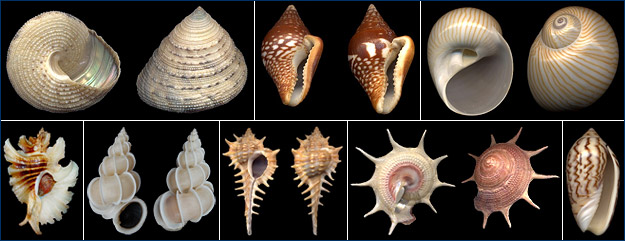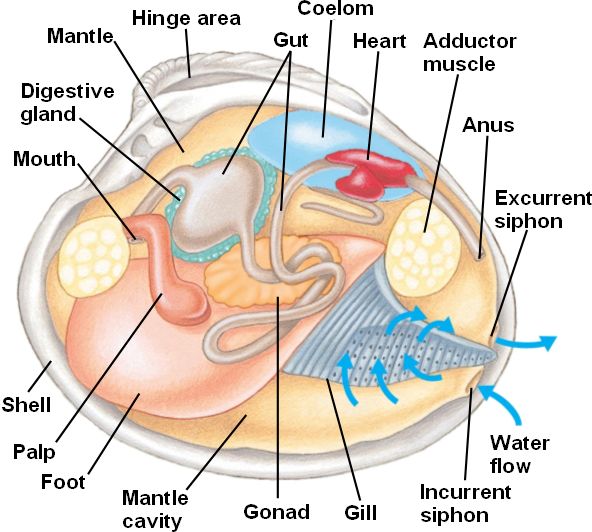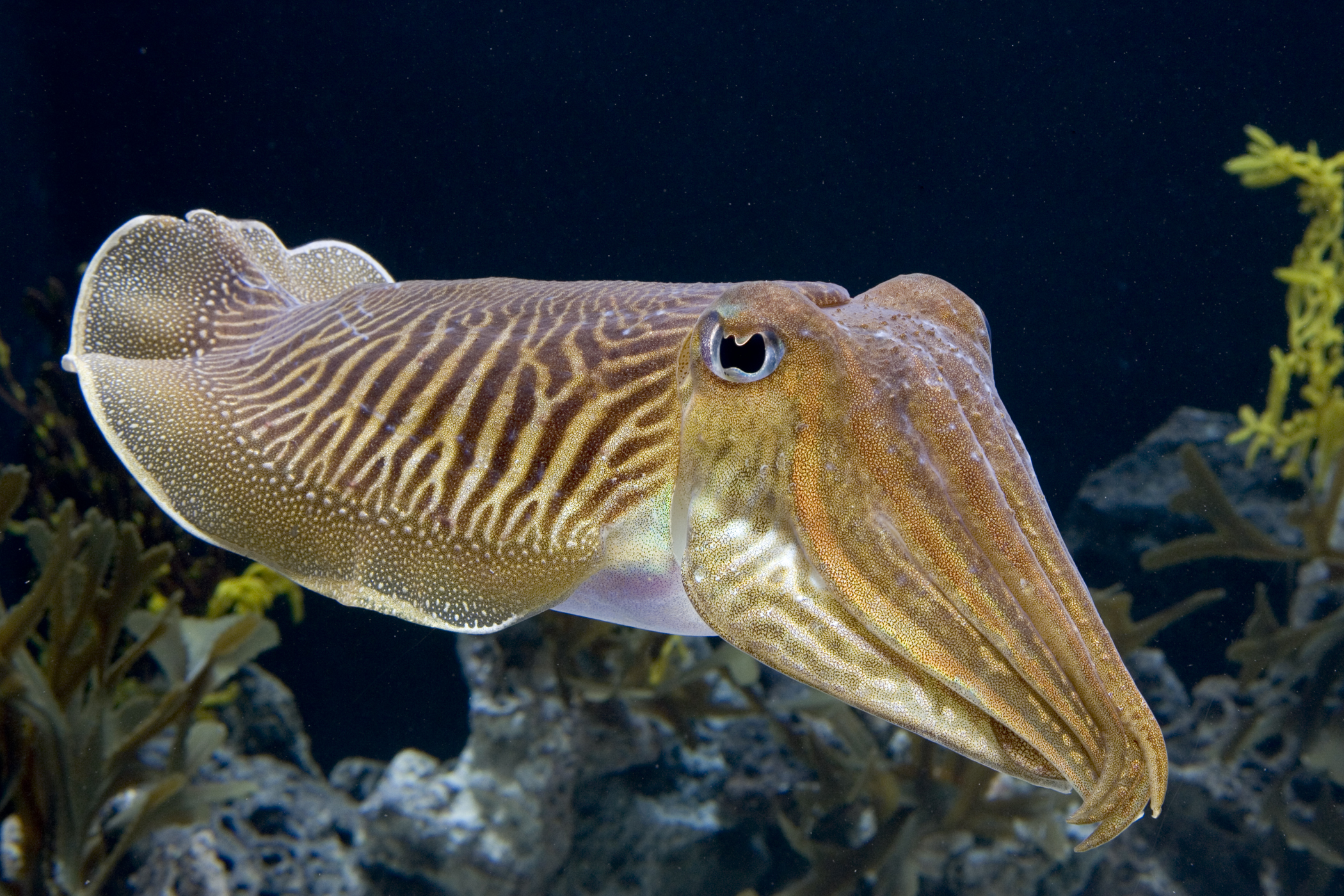Phylum Mollusca (Puhatestűek) - Molluscs or Mollusks
There are over 100 000 species in this phylum and scientists are constantly discovering new species.
Most molluscs live in the ocean, some live in freshwater and some live on land.
Most of the molluscs are free-living (not parasites).
Molluscs are often called a dead-end phylum, because (to-date) no other groups have evolved from them, but they are a very diverse and successful phylum.
Body Structure
- soft bodies
- exoskeletons (külsőváz) in the form of calcareous shells, although they have been lost through evolution of some groups, eg. squid (tintahal) have a reduced and internalized shell called a pen, slugs (meztelen csiga) and octopus have completely lost their shells.
- bilateral symmetry
- 2 body openings (they are protostomes - mouth developed from the blastopore)
- body formed of 3 zones
1. head-foot (separated in some species): contains the sensory and motor organs
2. visceral hump (zsigerzacskó): contains internal organs (digestive, excretory and reproductive)
3. mantle (köpeny): skin-like, it enfolds the visceral mass and excretes the shell
between the mantle and the visceral hump, there is a space called the mantle cavity (köpeny üreg), where the repiratory organs (gills or lungs) can be found. Internal organs also empty into the mantle cavity
 |
Classification
There are 7 classes of molluscs, but we will only cover 3 of the most common.
1. Gastropoda (csigák) - snails and slugs
 |
| Snail shells come in many different shapes, often with beautiful patterns |
- nervous system: ganglionic nervous system witha pair of cerebral ganglia (agydúc) and other ganglia and nerve cords throughout the body, light-sensitive eyespots are found at the ends of the upper tentacles and the head-foot is covered with touch-sensitive sensory cells
- open circulatory system: blood (actually called hemolymph) is pumped by a heart into open spaces around the organs
- respiratory system: 1st animals with a respiratory strucutres. Water-dwellers have gills, land-dwellers have primitive lungs
- nutrition: most are herbivores, some are predators, parasites or detritus-eaters (törmelékevők)
- reproduction: most species have separate sexes, although some are hermaphrodites (do not self-fertilize) and a few species exhibit sex changing (eg. begin life as a male and turn into a female later)
Notice that the visceral mass is twisted around in the snails, so the mantle cavity isn't at the back-end of the snail and the anus doesn't open at the posterior end (tail-end) of the snail, but rather above the "head region" (yes, the snail is pooping on its own head ;)!!). Also note that the top image is a land snail, while in the bottom image, the snail has gills, so must live in the water!
2. Bivalvia (kagylók) - clams, oysters (osztriga), mussels (kékkagyló), etc
- 2 shells joined together by a hinge (at the umbo)
- reproduction: most species have separate sexes, although some are hermaphrodites (do not self-fertilize) and a few species exhibit sex changing (eg. begin life as a male and turn into a female later)
| External view |
 |
| Internal view |
2. Bivalvia (kagylók) - clams, oysters (osztriga), mussels (kékkagyló), etc
- 2 shells joined together by a hinge (at the umbo)
- all bivalves live in water, most are marine.
- they have no distinct head and no radula
- movement: most are sessile, but some can use their foot to bury in the sand or mud, and scallops can swim
-the adductor muscles (anterior-front and posterior-back) are very strong muscles that control the opening and closing of the shells. They are very powerful and can contract and hold the shells (also called valves) closed for very long times and against very strong forces (eg. you cannot force a shell to open, you will break the external shell before the muscles relax).
- they have no distinct head and no radula
- movement: most are sessile, but some can use their foot to bury in the sand or mud, and scallops can swim
 |
| How a clam burrows |
-the adductor muscles (anterior-front and posterior-back) are very strong muscles that control the opening and closing of the shells. They are very powerful and can contract and hold the shells (also called valves) closed for very long times and against very strong forces (eg. you cannot force a shell to open, you will break the external shell before the muscles relax).
 | |
- shells grow as more material is secreted by the mantle at the edge of the shell
 |
| Diagram of the inside of a shell (valve) |
 |
| Inside of a real shell. See if you can name each of the labeled parts! |
 |
| Internal anatomy of a claim |
- nutrition: most are filter-feeders (scallops are predators). They trap food particles on their gills. The food then gets into their mouth and passes through the digestive system.
- respiration: they use their gills for gas exchange, in species buried in the sand or mud, the siphons reach up into the water and suck in and blow out water, which brings oxygen to the gills (and also food for feeding)
- open circulatory system: a single large heart, pumps blood (properly called hemolymph in these guys) into the spaces between the organs in the visceral mass
- nervous system: ganglionic nervous system with nerve cords, simple light and touch sensitive sensory cells are found on the edges of the mantle.
- reproduction: usually the sexes are separate, but in some species there is hermaphrodism. Sperm and eggs are released into the water column, this is called spawning and fertilization is external. The fertilized eggs become larva, which then develop into adults.
3. Cephalopods (fejlábúak)
This is the most complex class and the most recently evolved.
-all are marine
- includes the octopus, squid, cuttlefish (szépia hal) and nautilus
- includes the octopus, squid, cuttlefish (szépia hal) and nautilus
 |
| An octopus |
 |
| A squid |
 |
| A cuttlefish |
 |
| A nautilus |
- movement: jet propulsion, they squirt water out of the mantle cavity through the siphon/funnel to get a "fast start"
- they have many arms (fogókarok) with suckers (szívókorong), which are attached to the head and are specialized for moving along the bottom, swimming and catching prey. Squid also have fins to help with swimming
- number of arms is an easy way to identify different groups.
All octopus have 8 arms , squid and cuttlefish have 8 arms and 2 long tentacles (suckers only at ends) for catching prey, nautilus have about 90 tentacles (with no suckers)
- nutrition: predators, have a parrot-like beak to help tear apart prey
- respiration: they have gills found in the mantle cavity
- circulation: closed circulatory system, so blood flows in vessels throughout their body and is pumped by the systemic heart (there are gill hearts, especially to pump blood through the gills). This lets them be very active.
- nervous system: they have a complex brain controlling the nervous system. They have the most complex nervous system of all invertebrates. Their eyes are large, simple eyes, with excellent vision (except the nautilus). They also have chemical sense organs, as well as the sense of touch. Most have chromatophores (cells that change colour) that allow them to camoflage with their background. Most can also produce ink as a defense mechanism
- reproduction: mating occurs when the male becomes brightly coloured in front of another individual of the same species. If it is a female, she will become pale-coloured and they can mate (if the other turns brightly-coloured, then it is considered a warning to go away!). Most males have a specialized sperm-carrying arm, with which he inserts sperm into the female. She then lays the eggs in egg cases. Some species "brood" their eggs, so they stay and protect them. Others don't.
- they have many arms (fogókarok) with suckers (szívókorong), which are attached to the head and are specialized for moving along the bottom, swimming and catching prey. Squid also have fins to help with swimming
- number of arms is an easy way to identify different groups.
All octopus have 8 arms , squid and cuttlefish have 8 arms and 2 long tentacles (suckers only at ends) for catching prey, nautilus have about 90 tentacles (with no suckers)
- nutrition: predators, have a parrot-like beak to help tear apart prey
- respiration: they have gills found in the mantle cavity
- circulation: closed circulatory system, so blood flows in vessels throughout their body and is pumped by the systemic heart (there are gill hearts, especially to pump blood through the gills). This lets them be very active.
- nervous system: they have a complex brain controlling the nervous system. They have the most complex nervous system of all invertebrates. Their eyes are large, simple eyes, with excellent vision (except the nautilus). They also have chemical sense organs, as well as the sense of touch. Most have chromatophores (cells that change colour) that allow them to camoflage with their background. Most can also produce ink as a defense mechanism
- reproduction: mating occurs when the male becomes brightly coloured in front of another individual of the same species. If it is a female, she will become pale-coloured and they can mate (if the other turns brightly-coloured, then it is considered a warning to go away!). Most males have a specialized sperm-carrying arm, with which he inserts sperm into the female. She then lays the eggs in egg cases. Some species "brood" their eggs, so they stay and protect them. Others don't.
 |
| Internal anatomy of a squid |
No comments:
Post a Comment